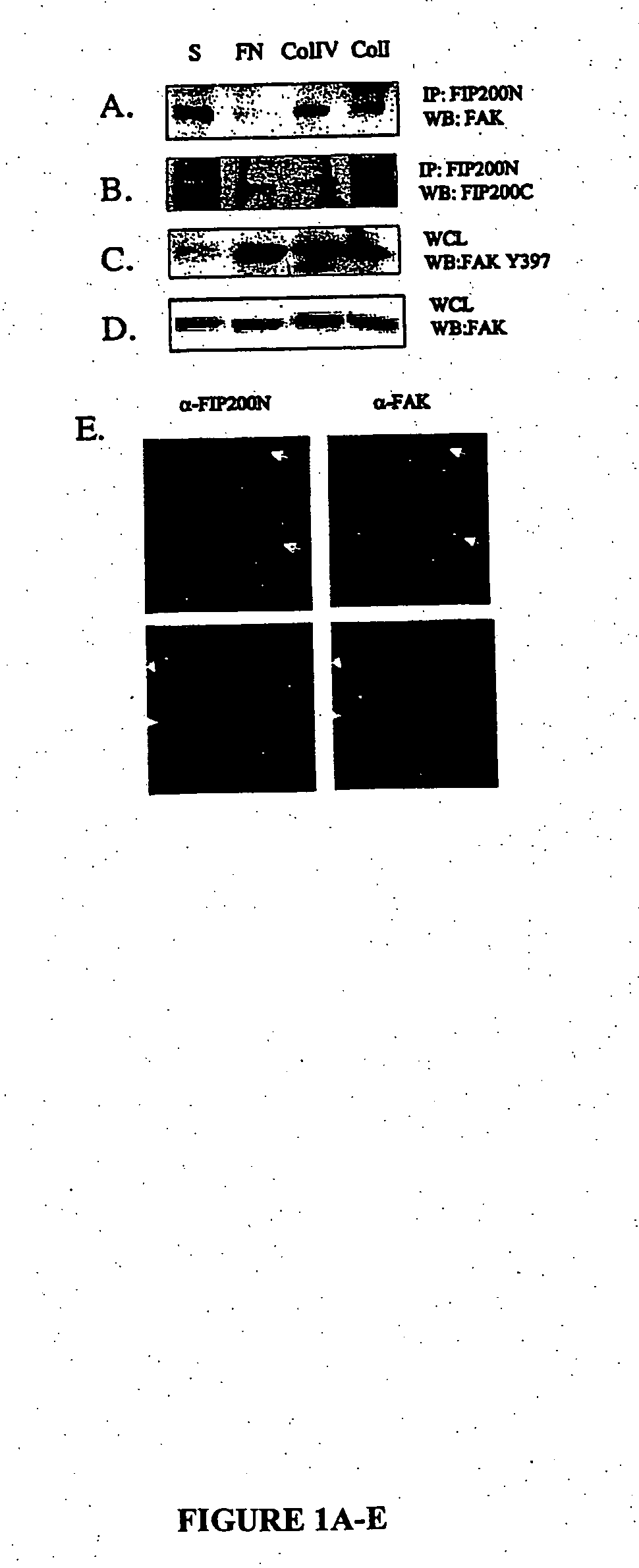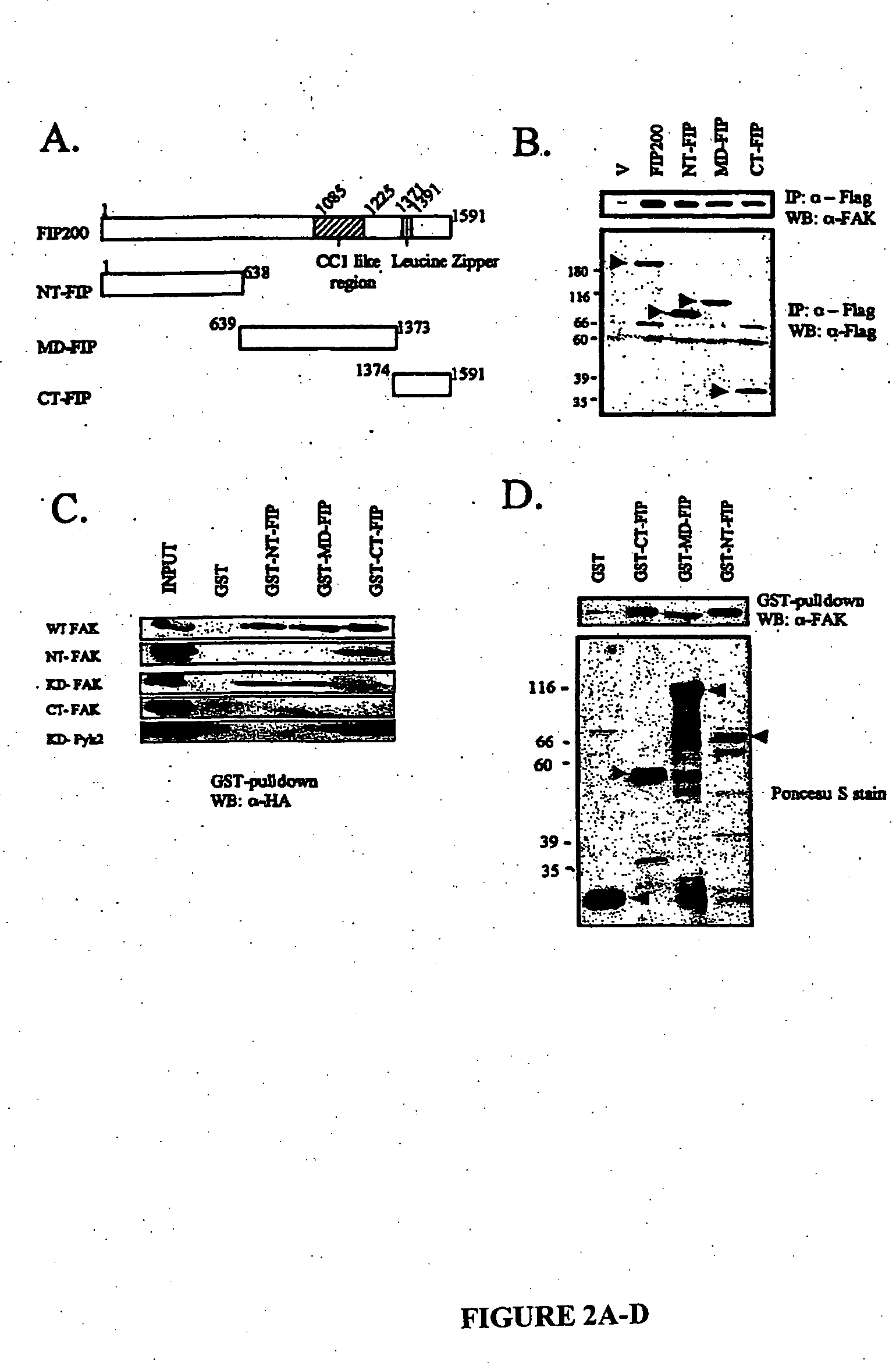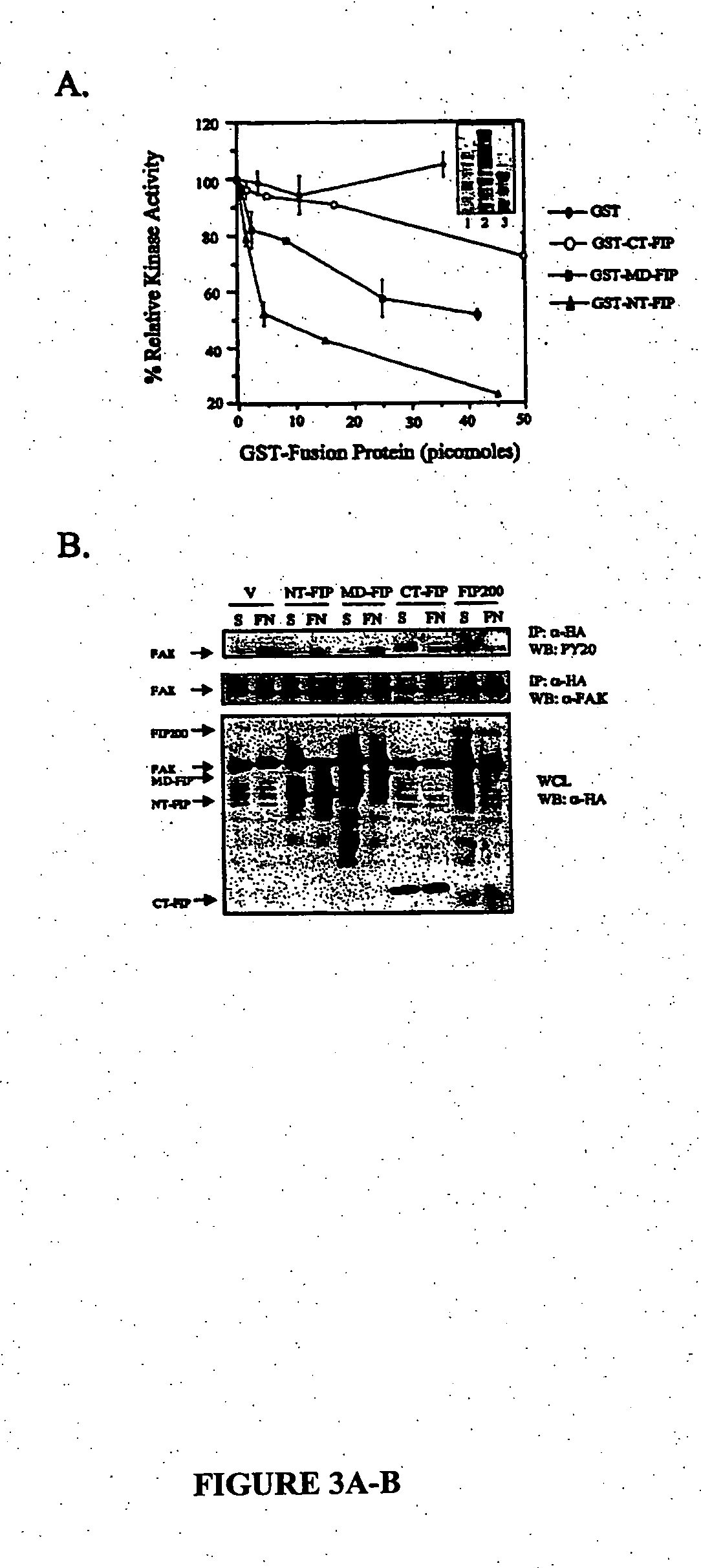Methods of regulating focal adhesion kinase and its associated cellular functions by fak family-interacting protein
a technology of focal adhesion kinase and fak family, which is applied in the field of methods of regulating focal adhesion kinase, can solve the problems of threatening the life of patients, no longer controlling their own proliferation, and complex and devastating cancer, and achieves the effect of inhibiting the cell proliferation disorder
- Summary
- Abstract
- Description
- Claims
- Application Information
AI Technical Summary
Benefits of technology
Problems solved by technology
Method used
Image
Examples
example 1
Preparation of Antibodies
[0089] Polyclonal antibodies against the C-terminal FIP200 (residues 1374-1591; anti-FIP200C; Ueda et al., “Suppressions of Pyk2 Kinase and Cellular Activities by FIP200,”J. Cell. Biol. 149:423-430 (2000), which is hereby incorporated by reference in its entirety), rabbit antiserum against FAK (Chen et al., “Association of Focal Adhesion Kinase With Its Potential Substrate Phosphatidylinositol 3-Kinase,”Proc. Natl. Acad. Sci. USA 91:10148-10152 (1994), which is hereby incorporated by reference in its entirety), mouse mAb KT3 (Cary et al., “Stimulation of Cell Migration by Overexpression of Focal Adhesion Kinase and Its Association With Src and Fyn,”J. Cell Sci. 109:1787-1794 (1996), which is hereby incorporated by reference in its entirety), and mouse mAb 12CA5 that recognize the hemagglutinin (HA) epitope tag (Chen et al., “Interaction of Focal Adhesion Kinase With Cytoskeletal Protein Talin,”J. Biol. Chem. 270:16995-16999 (1995), which is hereby incorpora...
example 2
Construction of Expression Vectors
[0090] The expression vectors pSG5-FIP200, pSG5-N-terminal-FIP 2, and pSG5-C-terminal-FIP (CT-FIP) encoding Flag-tagged full-length NT-FIP and CT-FIP have been described previously (Ueda et al., “Suppressions of Pyk2 Kinase and Cellular Activities by FIP200,”J. Cell. Biol. 149:423-430 (2000), which is hereby incorporated by reference in its entirety). pSG5-middle domain-FIP 4 encoding Flag-tagged middle domain of FIP200 was generated by amplifying residues 639-1373 of FIP200 using primers with EcoRV site at the 5′ end and BglIsite at the 3′ site. The region was subsequently cloned into the corresponding cloning sites in pSG5 vector. Similarly, expression vectors pKH3-FIP200, pKH3-NT-FIP, pKH3-MD-FIP, and pKH3-CT-FIP encoding HA-tagged FIP200 or fragments were generated by amplifying residues 1-1591, 1-638, 639-1373, and 1374-1591 with the addition of SmaI site at 5′ end and EcoRV site at 3′ end. These fragments were subsequently digested and cloned...
example 3
In Vitro Binding
[0094] GST fusion proteins were produced and purified using a protease-defective Escherichia coli strain BL21-Dex, as described previously (Ueda et al., “Suppressions of Pyk2 Kinase and Cellular Activities by FIP200,”J. Cell. Biol. 149:423-430 (2000), which is hereby incorporated by reference in its entirety). GST fusion proteins (3 μg) were immobilized on glutathione-agarose beads and were then incubated for 4 hours at 4° C. with lysates (200 μg) prepared from 293 cells that had been transfected with expression vectors encoding kinase domain of Pyk2, HA-FAK, or its fragments. After washing, the bound proteins were analyzed by western blotting with anti-HA (1:2000) as described below. For binding to the recombinant FAK, His-tagged recombinant FAK was purified from baculovirus-infected sf21 cells as described previously (Withers et al., “Expression, Purification and Characterization of Focal Adhesion Kinase Using a Baculovirus System,”Protein Exp. Purif. 7:12-18 (199...
PUM
| Property | Measurement | Unit |
|---|---|---|
| Adhesion strength | aaaaa | aaaaa |
| Cell proliferation rate | aaaaa | aaaaa |
| Spreading enthalpy | aaaaa | aaaaa |
Abstract
Description
Claims
Application Information
 Login to View More
Login to View More - R&D
- Intellectual Property
- Life Sciences
- Materials
- Tech Scout
- Unparalleled Data Quality
- Higher Quality Content
- 60% Fewer Hallucinations
Browse by: Latest US Patents, China's latest patents, Technical Efficacy Thesaurus, Application Domain, Technology Topic, Popular Technical Reports.
© 2025 PatSnap. All rights reserved.Legal|Privacy policy|Modern Slavery Act Transparency Statement|Sitemap|About US| Contact US: help@patsnap.com



